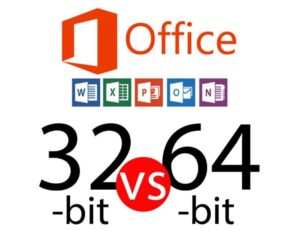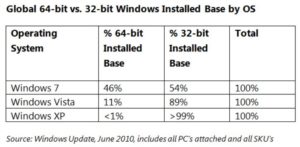 Microsoft has changed their guidance to state that from September 2018 on, they recommend the 64 bit version of Office be installed. This is a departure from the 32bit guidance Microsoft provided previously.
Microsoft has changed their guidance to state that from September 2018 on, they recommend the 64 bit version of Office be installed. This is a departure from the 32bit guidance Microsoft provided previously.
After Microsoft first compiled a 64 bit version of MS Office in June 2010, they immediately told consumers and companies not to use it. The issue was not cost, stability or features; they were all the same as the 32 bit version. The issues with 64 bit Office were:
 Your PC Operating System had to be 64 bit but in 2010 only about 90% of PC’s ran a 32bit version of Windows (see the table to the right).
Your PC Operating System had to be 64 bit but in 2010 only about 90% of PC’s ran a 32bit version of Windows (see the table to the right).
.- There were no 64 bit plug-ins. If you had an addin for Outlook, Excel, Word… it was guaranteed to be a 32 bit plug in because that was all that existed at the time.
Microsoft also people that the only notable improvement from the 64 bit version of MS Office was that Excel could handle much larger spreadsheet. 64bit Office was about the future. In 2010, very few people had worksheets that came anywhere near the limits:
Maximum limits of memory storage and file size for Data Model workbooks 32-bit environment is subject to 2 gigabytes (GB) of virtual address space, shared by Excel, the workbook, and add-ins that run in the same process. A data model’s share of the address space might run up to 500 – 700 megabytes (MB), but could be less if other data models and add-ins are loaded.
64-bit environment imposes no hard limits on file size. Workbook size is limited only by available memory and system resources.
SOURCE
Fast forward about a decade and we find:
- “big data” means that 32bit size and speed limits are causing more and more frustrations with Excel
- You would really have to look hard to find a Windows 10 PC running 32bit Operating System
- Plugin developers have had nearly a decade to get 64bit plugins ready
In addition to Excel, Microsoft now indicates that the 64 bit versions of Office apps will perform notably better than their 32 bit counterparts if you are working with:
- Very large graphics in PowerPoint,
- MS Project files larger than 2GB
- “Large Data Type” in MS Access
To be clear, Microsoft says you should stay with 32 bit MS Office if:
- You have 32-bit COM Add-ins with no 64-bit alternative. You can continue to run 32-bit COM add-ins in 32-bit Office on 64-bit Windows. You can also try contacting the COM Add-in vendor and requesting a 64-bit version.
-
You use 32-bit controls with no 64-bit alternative. You can continue to run 32-bit controls in 32-bit Office like Microsoft Windows Common Controls (Mscomctl.ocx, comctl.ocx), or any existing 3rd-party 32-bit controls.
- Your VBA code uses Declare statements Most VBA code doesn’t need to change when using in 64-bit or 32-bit, unless you use Declare statements to call Windows API using 32-bit data types like long, for pointers and handles. In most cases, adding PtrSafe to the Declare and replacing long with LongPtr will make the Declare statement compatible with both 32- and 64-bit. However this might not be possible in rare cases where there is no 64-bit API to Declare. For more information about what VBA changes are needed to make it run on 64-bit Office, see 64-Bit Visual Basic for Applications Overview.
- You have 32-bit MAPI applications for Outlook. With a growing number of 64-bit Outlook customers, rebuilding 32-bit MAPI applications, add-ins, or macros for 64-bit Outlook is the recommended option, but if needed you can continue to run them with 32-bit Outlook only, as well. To learn about preparing Outlook applications for both 32-bit and 64-bit platforms, see Building MAPI Applications on 32-Bit and 64-Bit Platforms and the Outlook MAPI Reference.
- You’re activating a 32-bit OLE server or object. You can continue to run your 32-bit OLE Server application with a 32-bit version of Office installed.
- You’re using SharePoint Server 2010 and you need the Edit in Datasheet view. You can continue to use the Edit in Datasheet view functionality in SharePoint Server 2010 with 32-bit Office.
- You need 32-bit Microsoft Access .mde, .ade, and .accde database files. While you can recompile 32-bit .mde, .ade, and .accde files to make them 64-bit compatible, you can continue to run 32-bit .mde, .ade, and .accde files in 32-bit Access.
- You require Legacy Equation Editor or WLL (Word Add-in libraries) files in Word. You can continue to use Legacy Word Equation Editor and run WLL files in 32-bit Word.
- You have an old embedded media file in your PowerPoint presentation with no available 64-bit codec.
SOURCE



7 Comments
Casey · October 18, 2019 at 11:25 am
Actually thats not true any more as of July 2019.
https://docs.microsoft.com/en-us/deployoffice/change-bitness
Ian Matthews · October 23, 2019 at 3:59 pm
Hi STR8JKT. 64bit Office is now not just recommended but also is now default.
Bryan · December 12, 2019 at 8:03 am
Ian – where is this recommendation published? Thanks!
Ian Matthews · December 27, 2019 at 8:00 pm
There are several sources including: https://support.office.com/en-us/article/choose-between-the-64-bit-or-32-bit-version-of-office-2dee7807-8f95-4d0c-b5fe-6c6f49b8d261 and if you surf to http://portal.office.com and click INSTALL OFFICE, it will install the 64bit automatically (although you can override it and select 32bit)
Jackie · September 11, 2019 at 7:07 pm
Please explain how to change from 32 bit version to the 64 bit version of office 2019 – I was not asked and the 32 bit version automatically installed. So, how do I switch? I have the option available for 64 bit.
thanks.
Ian Matthews · September 21, 2019 at 11:03 am
That is an excellent question Jackie. The short version is that there is no conversion from 32bit to 64bit and worse, the two are incompatible on the same PC. If you want to run even a single 64bit MS Office program (i.e. Project or Visio), ALL MS Office programs must be 64bit. They also need to use the same type of installation. There are two installation types, .MSI (traditional) and Click-to-Run (new), so you can’t have a 64Bit Visio Click-To-Run with a 64Bit Word .MSI. You may also find https://www.urtech.ca/2019/03/solved-64bit-office-cannot-be-installed/ and https://www.urtech.ca/2012/10/solved-should-you-use-the-32bit-or-64bit-version-of-office-2013/ useful as they are short and cover some history. Does that help?
Mike Tech Show – Podcast – #714 – 12-19-19 | Mike Tech Show · December 20, 2019 at 2:48 am
[…] SOLVED: Why Is 64 Bit MS Office Now Recommended? […]